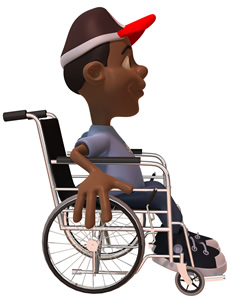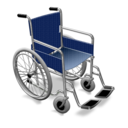
 For many who find themselves in a wheelchair, the dream of gracefully dancing across a ballroom dance floor does not seem a reality. Today, many dance studios are offering programs to make this dream possible for people with disabilities. Studios such as Nyemchek’s Dance Centre in Pearl River, NY are providing people with varying degrees of disability the opportunity to benefit from the social and physical components of wheelchair dancing. Wheelchair dancing or adaptive dancing allows for creativity and expression through movements of the body. The beauty of such programs is that all individuals, with and without disabilities, verbal or non-verbal, can participate.
For many who find themselves in a wheelchair, the dream of gracefully dancing across a ballroom dance floor does not seem a reality. Today, many dance studios are offering programs to make this dream possible for people with disabilities. Studios such as Nyemchek’s Dance Centre in Pearl River, NY are providing people with varying degrees of disability the opportunity to benefit from the social and physical components of wheelchair dancing. Wheelchair dancing or adaptive dancing allows for creativity and expression through movements of the body. The beauty of such programs is that all individuals, with and without disabilities, verbal or non-verbal, can participate.
Wheelchair Dance was founded in 1968 in Sweden by Els-Britt Larsson, a wheelchair user. The popularity of the sport grew with the first competitive meet being held in 1975. By 1977, the importance of wheelchair dancing was recognized with its first international competition. In 1978, the first World Championships were held in Japan and wheelchair dance became an official sport by Governance and Management Authority of the International Paralympic Committee.
Wheelchair dance brings together dancers with and without disabilities to reach a desired outcome of achieving success in a sport otherwise known for its emphasis on agility, coordination and balance. Dancers can learn a variety of dances including but not limited to waltz, slow foxtrot and tango. Those dances which allow for movement across the dance floor are easier to learn, however, samba, cha-cha and jive are also possible. Growing in popularity is line dancing and square dancing.
 Typically, the wheeler is coupled with an able-bodied dancer (combi-style dance). The able-bodied dancer leads while the wheeler propels the wheelchair. Each partner is responsible for learning the dance steps and keeping in time with the count of the music. In some cases, two wheelchair dancers perform in either manual or power chairs (duo dance). Impressive to all is the group dance which incorporates wheelchair dancers and able-bodied dancers who synchronize their movements. For younger wheelchair dancers, there is a freestyle or single dance where the wheelchair dancer dances alone.
Typically, the wheeler is coupled with an able-bodied dancer (combi-style dance). The able-bodied dancer leads while the wheeler propels the wheelchair. Each partner is responsible for learning the dance steps and keeping in time with the count of the music. In some cases, two wheelchair dancers perform in either manual or power chairs (duo dance). Impressive to all is the group dance which incorporates wheelchair dancers and able-bodied dancers who synchronize their movements. For younger wheelchair dancers, there is a freestyle or single dance where the wheelchair dancer dances alone.
Programs such as Roll Call Wheelchair Dance at Nyemchek’s Dance Centre are not only for those individuals whose means of mobility is a wheelchair. Individuals with movement disorders such as Parkinson’s Disease, or the early stages of Amyotrophic Lateral Sclerosis (commonly known as Lou Gehrig’s Disease) also benefit from the choreographed and coordinated movements intended to target specific muscle groups. Aspiring dancers with neurological conditions such as Multiple Sclerosis thrive in such programs as the activity is graded from a seated position to standing with consideration given to the sustained activity tolerance of the participant.
The benefits of wheelchair dancing extend beyond the obvious element of socialization. A wheelchair dancer is afforded the opportunity to build confidence in a social setting. For many in wheelchairs, they find themselves isolated from peers and excluded from activities commonly known for able-bodied people. The slow, rhythmic movements help to reduce stress and decrease muscle tone while at the same time, increasing coordination and increasing muscle strength. The wheelchair dancer is improving core strength which in turn increases stamina and decreases pressure on the lungs brought upon from sitting in a slouched position. Weight management, which can be a concern from being primarily sedentary, is addressed in the physical nature of dancing. Psychologically, wheelchair dancers can develop friendships and lessen feelings of depression.
In today’s society where each of us is touched by someone with a form of a disability, it is our calling as able-bodied individuals to highlight the abilities in each of these amazing and resilient people. Through such programs, ballroom dancing is brought to the disabled community allowing for the empowerment of each participant to actively participate in an activity which is beneficial for their mind, body and spirit.
– Victoria Marin is the author of Aiden’s Waltz which is a sublimely reflective tale of a young boy with Autism who journeys to find acceptance and strength within himself. From peering through a frosted window while watching boys and girls playing soccer, Aiden rises from the shackles of Autism as he dances across the ballroom dance floor with the grace and elegance of a swan. Visit www.aidenswaltz.com for additional information.
Photo credit: Julien Tromeur

Thank you for sharing the message of the importance of fitness for individuals with special challenges!
My pleasure and honor Victoria.